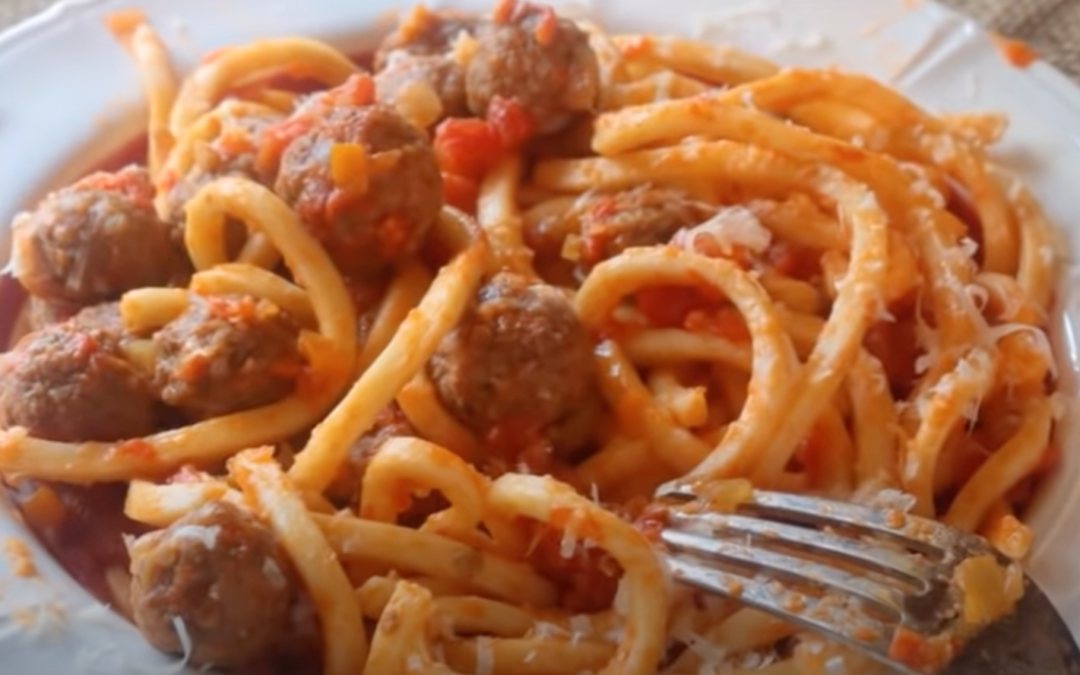A typical first course from Abruzzo
Maccheroni alla chitarra, or better-known in Abruzzese dialect as “maccheroni carrati”, is a traditional pasta dish coming from Abruzzo region, whose name has, however, French origins. Although this dish has been part of the Italian tradition for centuries, its name stems from the French verb “carrer” meaning to square, stating in fact the tool used to shape this type of long pasta which is the “carratore”, thereof the name “maccheroni carrati”. It is also known as “maccheroni alla chitarra”, because they look like a guitar’s sounding box, indeed “chitarra” means guitar in Italian.
Visualizza questo post su Instagram
A dish that goes beyond pasta
Quality instead of quantity is the main secret in Italian cooking, therefore, maccheroni carrati also stick to this rule, because out of basic ingredients such as eggs and flour, we are able to cook delicious pasta, really loved all around Italy (and not only). Certainly, as everybody knows, pasta must be served with sauce and what’s better than “ragù abruzzese”? Abruzzese ragout is famous in Italy because it is made of a mix of 4 different types of meat including first of all lamb (the most consumed meat in Abruzzo and central Italy), then pork, veal or beef and at times, even pancetta. Although its simplicity, this hearty and nutritious meal is perfect for special occasions and to amaze your guests.
Visualizza questo post su Instagram
How to prepare maccheroni carrati
If you want to try to prepare the authentic maccheroni carrati, be ready to hand roll pasta and cut it as a “chitarra”, that is cutting the dough into little square threads.
Ingredients:
For Egg Pasta dough
- 300gr “00” flour
- 1 tablespoon semolina flour, plus more for dusting the work surface and the dough
- 1/2 teaspoon fine sea salt
- Pinch of freshly grated nutmeg
- 3 extra-large eggs
- 1 to 2 tablespoon extra-virgin olive oil
For the Abruzzese ragout:
- 3 tablespoons vegetable olive oil
- 150gr boneless beef chuck roast, cut into 4 equal pieces
- 150gr boneless pork shoulder, cut into 3 equal pieces
- 150gr boneless lamb shoulder, cut into 3 equal pieces
- fine sea salt
- Freshly ground black pepper
- 3 pounds whole or diced canned tomatoes, with their juice
- 1 yellow onion, finely chopped
Instructions for ragout:
Warm the oil in a large oven or other heavy-bottomed pot placed over medium heat. Season the pieces of meat with a little salt and pepper and add them to the pot. Brown for 3 to 4 minutes, then turn the pieces to brown the other side, another 3 to 4 minutes. Continue to brown the meat until it is nicely seared all over and set the pot aside.
Return the pot to medium heat and add the extra-virgin olive oil. Stir in the onion, reduce the heat to medium-low, and sauté for about 5 minutes. Pour in the tomatoes, raise the heat to medium-high, and bring to a simmer. Return the meat to the pot and reduce the heat to medium-low or low to maintain a gentle simmer. Cover partially and let the sauce simmer, stirring it from time to time, for about 3 hours, or until the meat is very tender and the sauce is thickened. Taste and adjust the seasoning with salt and pepper, as you better like.
Instructions for the egg pasta dough:
To mix the dough in the food processor: Put 2 cups “00” flour, the 1 tbsp semolina flour, salt, and nutmeg into the work bowl and pulse briefly to mix together. Break the eggs into the work bowl and drizzle in 1 tbsp of the olive oil. Process the dough, pinch together a bit of the mixture and roll it around. It should form a soft ball. If the mixture seems dry, drizzle in the remaining 1 tbsp oil. If it seems too wet and sticky, add additional flour, 1 tbsp at a time, and knead briefly.
Knead the dough for several minutes until the dough is smooth and silky. Form it into a ball and wrap it tightly in plastic wrap. Let the dough rest at room temperature for 30 minutes before stretching it.
Stretching the dough: Set up your pasta machine with the rollers on the widest setting. Scatter a little semolina flour on the work surface around the machine and have more on hand for sprinkling on the dough.
Cut the dough into four equal pieces, and rewrap three pieces. Knead the remaining piece briefly on the work surface. Then, using a rolling pin or patting it with the heel of your hand, form the dough into an oval. Feed the dough through the rollers of the pasta machine, and then lay the strip on the work surface.
Repeat the folding and rolling process a few more times, until the strip of dough is smooth. Continue to pass the dough through the rollers twice on each setting, until you have stretched it to the appropriate thickness.
Once you have stretched your piece of dough (it will be a fairly long ribbon, depending on how thin you have stretched it), lay it out on a semolina-dusted surface and cover it lightly with plastic wrap while you stretch the remaining 3 pieces.
Enjoy your meal!

